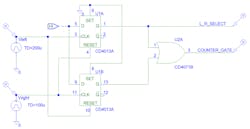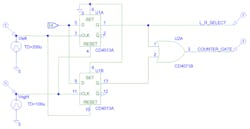Gated Counter Determines Which of Two Pulses Came First (.PDF Download)
In many applications, there’s a need to determine the difference in arrival time of two pulses, such as those derived from acoustic signals emanating from a single moving source. In this circuit, logic signals indicate the timing of the acoustic signals with good fidelity. (An analog front end, not shown here, shapes the analog signals and converts them to digital-logic signals.)
This circuit uses a dual-D flip-flop and an OR gate (Fig. 1) that provides a positive-polarity gate signal as well as an indication of which pulse came first, to be used by an MCU counter. Note that the OR gate could be eliminated if two MCU counters were used, one for each of the U1A Q and U1B Q outputs. In that case, only one of the two counters would accumulate counts, depending on which pulse arrived first and the time of arrival of the second pulse. Then, with additional coding, it would be possible to determine which pulse came first, and by how much.
1. By controlling timer count, this dual flip-flop circuit can determine which of two pulses arrived first.

